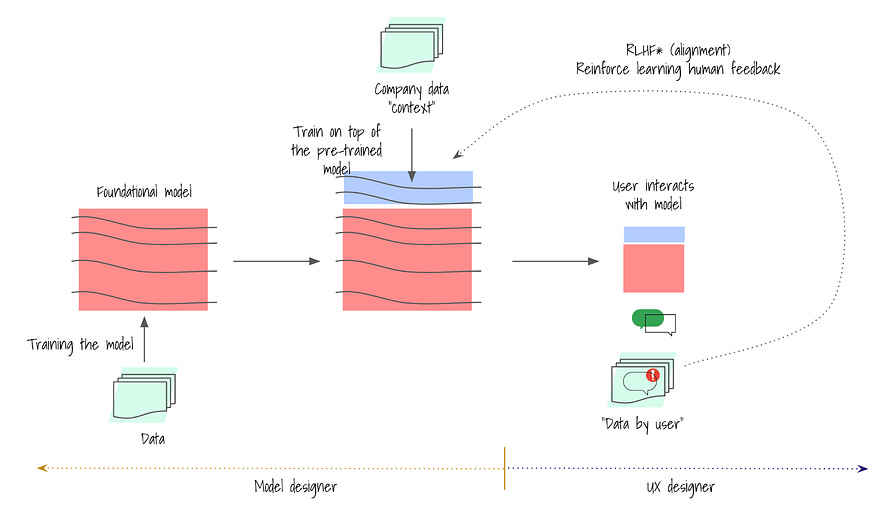The rise of the Model Designer
How designers should embrace shaping AI models.
For the past year, with the growing proliferation of AI models accessible to everyone, designers have been busy imagining new products and revamping existing ones. We’ve been focused on how people can interact with these models to solve problems in fresh, innovative ways. It’s like a design gold rush, full of excitement and exploration.
However, there’s a crucial piece missing: we’re mostly focused on the interface (how people use the models) without digging into the core (the models themselves). This core holds a key piece to a truly user-friendly and responsible future.
Right now, we’re treating these AI models like tools, but these models are much more, as Cassie Kozyrkov explains, they are also raw material. They are like clay that needs shaping, particularly as so much of the user experience is now embedded in the model itself.
Issues like hallucinations, privacy, and biases aren’t just problems users encounter when interacting with AI models. These issues are deeply woven into the very way the models are built. To address them effectively, we need to collaborate even more closely with the engineering teams than what we have done so far.
In response to all this, a new design role is emerging, a figure I am calling: the Model Designer. These specialists work alongside traditional UX teams who focus on the interactions between user and product. Unlike them, Model Designers delve deeper, working directly with the engineers developing AI models.
For small design teams, the Model Designer role might be an additional responsibility for existing team members. This means learning new skills and taking on new tasks related to shaping AI models. For larger companies, with more established design practices, the Model Designer would be a dedicated collaborator, or a holistic UX team.
A specialist can bring their vertical expertise in AI model development to the design process, working alongside interface designers to create a better product. Their combined skills encompass the entire workflow.
A few examples:
Prompting is extremely painful, even when using frameworks as a guide, it requires a big cognitive load for the user. UX designers can mitigate it by creating contextual suggestion chips. Model designers can craft system-level prompting, like a preamble, or even go deeper and collaborate on shaping a dataset for fine-tuning. For context, from the Cohere blog: A preamble contains instructions to help steer a chatbot’s response toward specific characteristics, such as a persona, style, or format*, liberating users from writing lengthy text.
To address potential biases, model designers can partner with engineers to implement strategies such as blocking specific words in certain contexts. User experience designers can complement these efforts by incorporating disclaimer language within the interface to minimize potential harm caused by biased responses.
Hallucinations could be minimized by grounding the model, both UX and Model designers could work together to develop a robust feedback cycle, alongside the engineering team. Following Anthropic’s approach, the model designer can also create a set of principles (or constitution) for adversarial training, where an antagonistic model would challenge the outputs from the original model.
Working together in a new way would also mean new collaboration artifacts, a sort of service design blueprints focusing on open-ended use cases. PAIR (People + AI research by Google) is releasing some collaboration frameworks around interaction design policies when working with AI models, instead of just tasks.
Beyond those examples of how a model designer can collaborate, as AI progresses, there is a wider need to redefine roles. Companies are restructuring design teams, and in many cases there is no clarity on the role responsibilities. For most teams not working on AI projects, people are not even aware of the new roles emerging.
Content designers are now creating detailed guidelines to training models, lifting most of the weight, as language is the currency of most AI models. Their daily tasks differ vastly from classic content designers, working on the interaction side, however, they maintain the same title.
Researchers are imagining how data sets reflect user intent, and aligning them with the personas they have developed. Conversational designers, working on AI assistants, are breaking from traditional decision trees, and creating sets of prompts.
UX designers are moving to a strategic plane where they can coordinate the shaping of the model and the interaction needed on the user’s end.
Models designers are all of the above; there are many entry points, and many skills to master. It demands a blend of technical knowledge, excellent writing, and a deep understanding of the end-to-end user experience. Beyond specific roles, designers from all backgrounds should have an understanding of how models work. Being forever curious has never been more needed.
It’s an exciting time for our craft.




